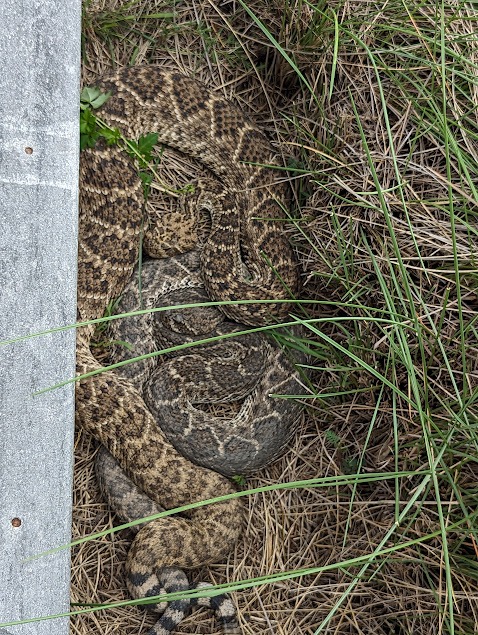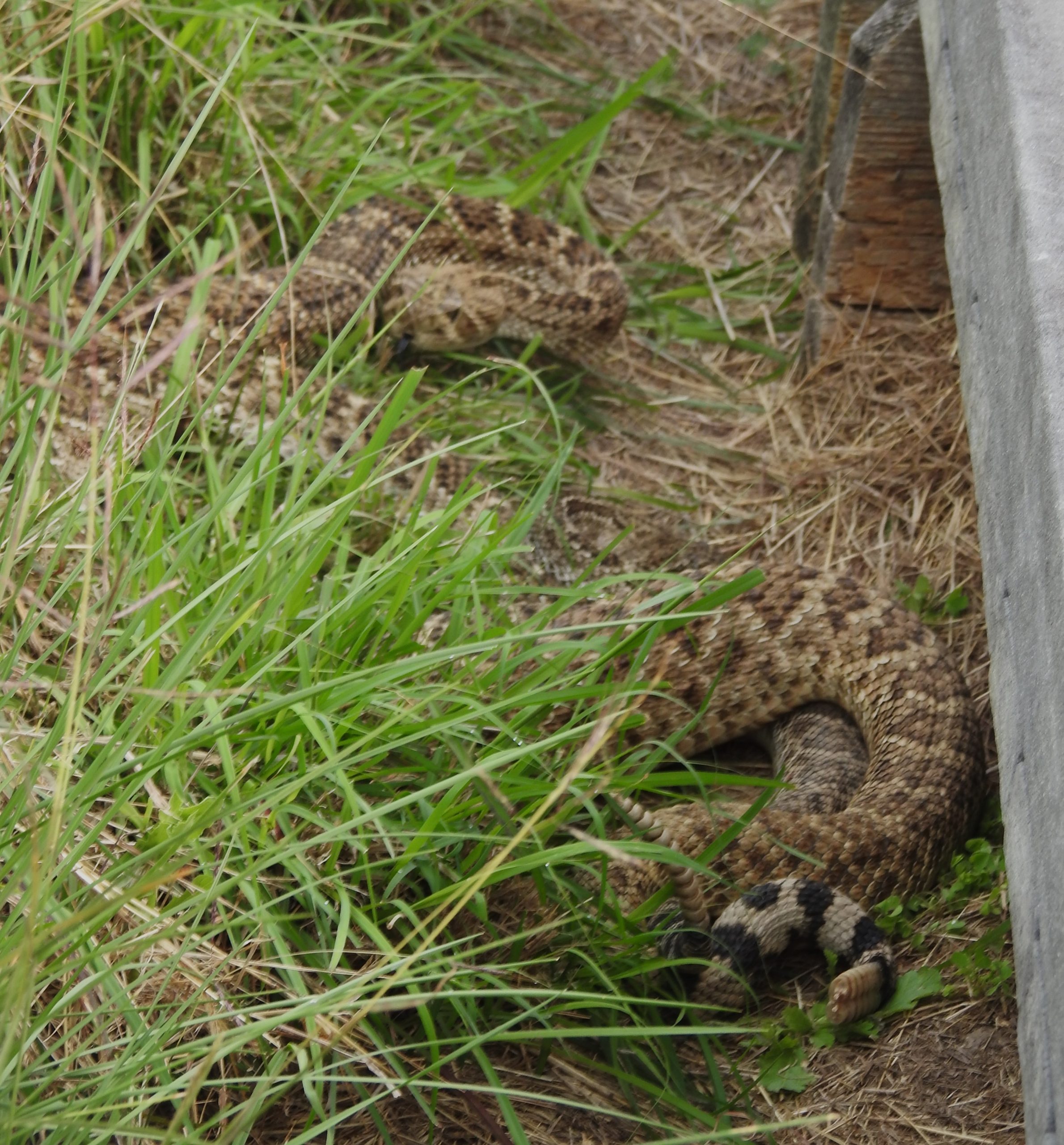An S-shaped figure—with a triangle head, stripy rattle and Y-shaped tongue—illustrates this helpful warning in English and Spanish: “Caution: Watch for Snakes In Brush and Along Trail” at Palo Alto Battlefield National Historical Park. I gaze ahead and tread carefully. Yet I, like many, have yearned to see a rattlesnake—at a safe distance.
But, after 40-odd years of scouring cactus and mesquite-filled scrublands in Cameron County and elsewhere, I saw nary a rattlesnake—not until one Sunday in mid-March when, to my glee, I witnessed two snakes mating alongside a raised boardwalk near the visitors center at Palo Alto.
Seeing another visitor’s photo of rattlesnakes, I embarked on a quest. A park employee, noting my zeal, led me to the site, showing me that the rattle ends of the snakes’ tails were entwined, a tell-tale sign they were mating. Since the pair was busy—and might be engaged thusly for hours—I stood near, then upon, the boardwalk, content that I could safely observe them without engaging in the foolhardy behavior of those who closely approach dangerous animals like bears, buffalo, and, yes, vipers like these, in pursuit of a perfect photo. Then, four days later, I once more saw the couple lolling together a few yards off, the male, presumably, guarding his mate from rival suitors.
Locally, these snakes mate in late February to early April and give birth to from 10 to 20 live snakes in late July to early August. Hatchlings stay with their mothers for only a couple of hours, after which they depart, following their instincts to prey upon large insects, lizards, frogs or recently-born rodents—while avoiding becoming prey themselves.
Most rattlesnake bites occur on people’s hands and feet, suggestive of unwise or incautious actions. Clint Guardiana, curator of reptiles and amphibians at the Gladys Porter Zoo, said, “Usually when a bite occurs, it’s because a person is actively trying to kill the rattlesnake, or even trying to pick it up.” Still, rattlesnake bites in Cameron County are rare. As is often the case, we are more apt to harm them—most often with vehicles. It is “extremely common, “said Guardiana, to find dead rattlesnakes on the road, and he has “found 20-30 roadkill rattlesnakes in a night.”
Preferring arid thorn scrub, the western diamondback rattlesnake (Crotalus atrox) thrives at Palo Alto and Laguna Atascosa National Wildlife Refuge, while appearing only rarely in more wooded areas like Sabal Palm Sanctuary and Resaca de la Palma State Park. Pablo Quintanilla, sanctuary manager at Sabal Palm, said, “I have only ever seen two here, right by the border wall, before any of our habitat actually begins,” adding that the refuge has “a healthy population” of Texas indigo snakes, a species that preys on rattlesnakes.
Jim Campbell, a longtime resident and reptile enthusiast, said the rattlesnakes also live on South Padre Island, saying, “I’ve seen photos of some found in trash washups” on the northern Island. “They tend to move to areas where they can find cover, food and water,” he said, and during scorching heat, “the search for water becomes dominate.” He recalled a local child’s being bitten when retrieving a ball “from under his house”. Campbell noted, “The land across the street had been cleared for construction,” and the snake, “pushed from his habitat”, sought “the closest cover.”
Lee Bragg, Palo Alto’s biological technician, and other employees often find rattlesnakes curled up near the visitors center in the morning, likely seeking water or, as Campbell noted, prey, like rabbits, “that the sprinklers attracted.” Bragg said personnel “encourage them to move on”, sometimes by throwing ice on them, so no visitor is surprised.
Though the venom of a western diamondback can cause devasting damage —destroying blood and tissue, attacking the nervous system and certain organs—from 25% to 50% of bites are “dry” or contain no venom, though any bite still requires medical care. Also, rattlesnake antivenom is widely available. According to Texas Parks and Wildlife statistics, one or two Texans dies annually from snakebites of any kind.
In rattlesnake habitat, we should scan ahead, stay on any designated trails and back at least ten steps away if we encounter a snake, patiently waiting for it to move, if necessary. It’s best to wear long, loose pants and hiking boots and step on rather than over boulders or limbs, for a snake could be on the other side.
If bitten, one’s top priority must be to get to a hospital for antivenom. According to Mayo Clinic, a snakebite victim should move well away from the creature and remain calm so venom does not quickly spread. One should remove rings or watches, anything tight. If unable to reach a medical facility right away, one should keep the bite below the heart, clean the wound with soap and water and wrap it loosely.
The remedies we see in old manuals and movies—applying ice or a tourniquet, cutting and sucking out venom— are ineffective and can cause severe damage to tissue.
Most of us, thank goodness, no longer categorize animals into a hierarchy of “good” and “evil”, and, heeding the lessons of The Lion King, appreciate the “circle of life”. In the 1930s, my grandfather, a Panhandle rancher, offered his offspring a dollar for each snake they killed. Western diamondbacks, unlike some rattlesnake species, appear to be faring well, but we must respect them and their habitat. They help us keenly by keeping our rodents under control. They have no desire to harm human beings, so if they’re surprised, stepped on or handled, they defend themselves, as would any creature.


